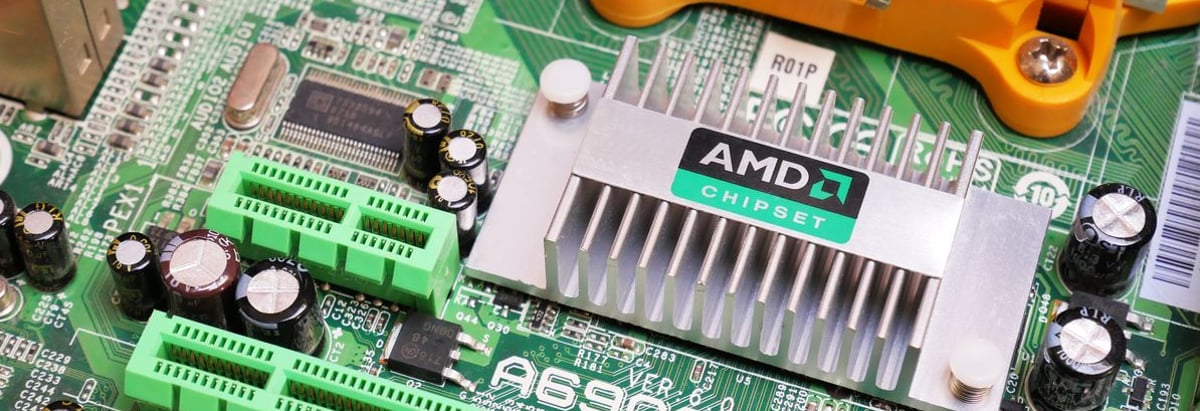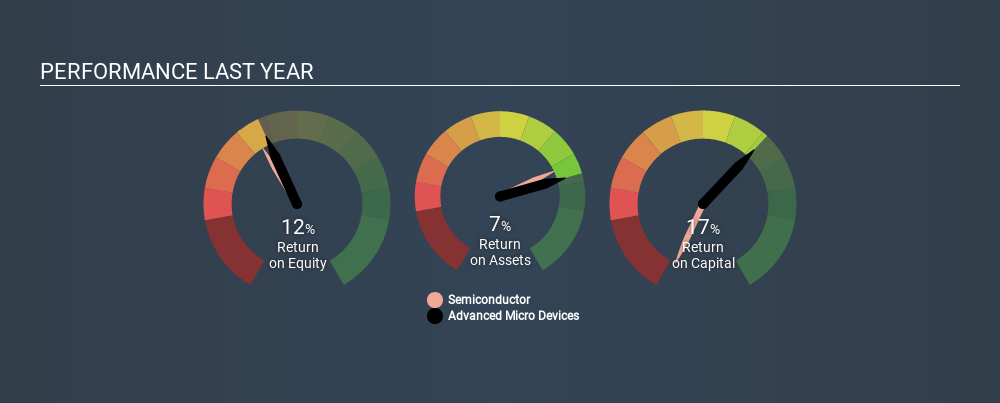- United States
- /
- Semiconductors
- /
- NasdaqGS:AMD
Is Advanced Micro Devices, Inc.’s (NASDAQ:AMD) 17% ROCE Any Good?

Today we are going to look at Advanced Micro Devices, Inc. (NASDAQ:AMD) to see whether it might be an attractive investment prospect. In particular, we'll consider its Return On Capital Employed (ROCE), as that can give us insight into how profitably the company is able to employ capital in its business.
Firstly, we'll go over how we calculate ROCE. Next, we'll compare it to others in its industry. And finally, we'll look at how its current liabilities are impacting its ROCE.
What is Return On Capital Employed (ROCE)?
ROCE is a measure of a company's yearly pre-tax profit (its return), relative to the capital employed in the business. Generally speaking a higher ROCE is better. In brief, it is a useful tool, but it is not without drawbacks. Renowned investment researcher Michael Mauboussin has suggested that a high ROCE can indicate that 'one dollar invested in the company generates value of more than one dollar'.
So, How Do We Calculate ROCE?
The formula for calculating the return on capital employed is:
Return on Capital Employed = Earnings Before Interest and Tax (EBIT) ÷ (Total Assets - Current Liabilities)
Or for Advanced Micro Devices:
0.17 = US$631m ÷ (US$6.0b - US$2.4b) (Based on the trailing twelve months to December 2019.)
Therefore, Advanced Micro Devices has an ROCE of 17%.
Check out our latest analysis for Advanced Micro Devices
Is Advanced Micro Devices's ROCE Good?
ROCE is commonly used for comparing the performance of similar businesses. Advanced Micro Devices's ROCE appears to be substantially greater than the 9.9% average in the Semiconductor industry. I think that's good to see, since it implies the company is better than other companies at making the most of its capital. Independently of how Advanced Micro Devices compares to its industry, its ROCE in absolute terms appears decent, and the company may be worthy of closer investigation.
Advanced Micro Devices delivered an ROCE of 17%, which is better than 3 years ago, as was making losses back then. This makes us wonder if the company is improving. The image below shows how Advanced Micro Devices's ROCE compares to its industry, and you can click it to see more detail on its past growth.

Remember that this metric is backwards looking - it shows what has happened in the past, and does not accurately predict the future. Companies in cyclical industries can be difficult to understand using ROCE, as returns typically look high during boom times, and low during busts. This is because ROCE only looks at one year, instead of considering returns across a whole cycle. Future performance is what matters, and you can see analyst predictions in our free report on analyst forecasts for the company.
What Are Current Liabilities, And How Do They Affect Advanced Micro Devices's ROCE?
Current liabilities include invoices, such as supplier payments, short-term debt, or a tax bill, that need to be paid within 12 months. The ROCE equation subtracts current liabilities from capital employed, so a company with a lot of current liabilities appears to have less capital employed, and a higher ROCE than otherwise. To check the impact of this, we calculate if a company has high current liabilities relative to its total assets.
Advanced Micro Devices has total assets of US$6.0b and current liabilities of US$2.4b. As a result, its current liabilities are equal to approximately 39% of its total assets. With this level of current liabilities, Advanced Micro Devices's ROCE is boosted somewhat.
Our Take On Advanced Micro Devices's ROCE
With a decent ROCE, the company could be interesting, but remember that the level of current liabilities make the ROCE look better. There might be better investments than Advanced Micro Devices out there, but you will have to work hard to find them . These promising businesses with rapidly growing earnings might be right up your alley.
I will like Advanced Micro Devices better if I see some big insider buys. While we wait, check out this free list of growing companies with considerable, recent, insider buying.
If you spot an error that warrants correction, please contact the editor at editorial-team@simplywallst.com. This article by Simply Wall St is general in nature. It does not constitute a recommendation to buy or sell any stock, and does not take account of your objectives, or your financial situation. Simply Wall St has no position in the stocks mentioned.
We aim to bring you long-term focused research analysis driven by fundamental data. Note that our analysis may not factor in the latest price-sensitive company announcements or qualitative material. Thank you for reading.
About NasdaqGS:AMD
Flawless balance sheet with reasonable growth potential.
Similar Companies
Market Insights
Community Narratives



